Nice work if you can get it

Job satisfaction in the United States reportedly hit a 20-year low last year, but the word apparently hasn't reached the logistics professionals who read DC Velocity. Nearly nine out of 10 respondents to our latest career and salary survey say they love their work and wouldn't hesitate to recommend the logistics profession to someone entering the job market.
And the money's not bad either. The average salary of the 1,138 readers who completed our online questionnaire in February was comfortably in the six figures—$100,502, to be precise. And it appears that the recession-era wage freezes are starting to thaw. Nearly 60 percent of the survey respondents indicated their compensation had risen in the past 12 months, while just 11 percent reported a drop.
Who earns what?
So what determines how much a particular logistics professional earns? As it turns out, a host of factors come into play—everything from age and experience to gender, company size, and region of the country. But as our surveys have consistently shown from year to year, one factor trumps them all: job title.

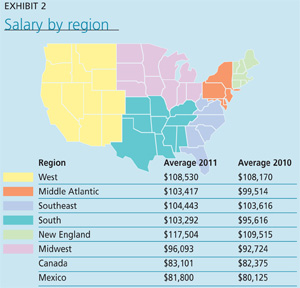
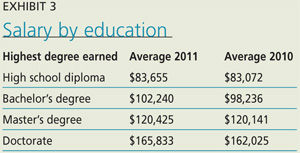
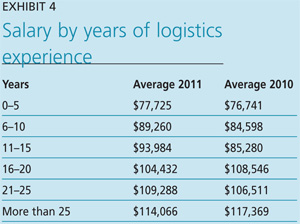
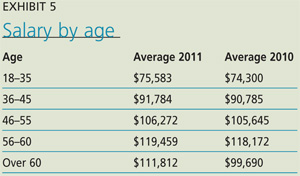
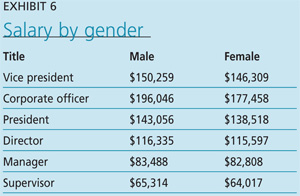
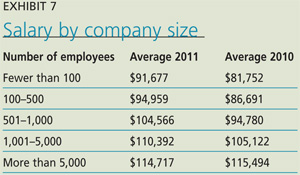
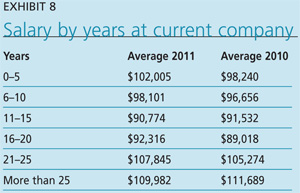
As for the correlation between pay and job title, generally speaking, the higher the position on the corporate ladder, the higher the compensation. However, as Exhibit 1 shows, there was one exception to that rule this year. While you'd ordinarily expect to find company presidents pulling down more than vice presidents, in this case, it was the other way around. The average salary for the vice presidents who participated in our study was $150,259, while the average salary for the presidents was $143,056.
Another factor that holds significant sway over salaries is geography. As Exhibit 2 shows, there was wide variation in the average salaries reported in different regions of the country. Past surveys have found a close connection between pay scales and the cost of living in various locales. This year was no exception: The highest average salaries were found in New England ($117,504) and the West ($108,530), areas known for being expensive places to live.
Education also counts when it comes to pay. This year's study once again confirmed that the longer you stay in school, the greater your earning power (see Exhibit 3). The average salary for logistics professionals who had earned a Ph.D. was $165,833, while the average pay for those whose formal education ended with high school was $83,655.
Not surprisingly, the study also showed a clear and direct correlation between years of experience in the logistics profession and salary. As Exhibit 4 shows, respondents with more than 25 years' experience in the business command a significant premium for their expertise. The average salary for this group was $114,066, compared with just $77,725 for those who've been in the field five years or less.
In addition to education and years in the profession, age plays a role in determining the size of a logistics professional's paycheck. This year's survey found that salaries increased with age—but only up to a point. As Exhibit 5 shows, that point occurs somewhere around age 60. While respondents aged 56 to 60 earned $119,459 on average, those over 60 brought home a more modest $111,812—a possible indication that some members of this group have transitioned to part-time or semi-retired employment status.
Mind the gap
As has been the case with our previous salary surveys, the latest study showed that when it comes to pay, the gender gap persists. Despite a multi-decade push for pay equity, females working in the logistics profession still lag behind their male counterparts. The average salary for men who participated in our study was $102,980; the average salary for their female counterparts was a full 20 percent lower, at $82,184. And the disparity can't be explained away by differences in job title. As Exhibit 6 shows, the salary gap persists regardless of position.
As for other factors that influence pay, our survey also showed that company size and respondents' tenure with their current employer play a role. As you might expect, the bigger the company you work for, the better the pay. Logistics professionals at companies with more than 5,000 employees, for instance, earn $114,717 on average, while their counterparts at companies with fewer than 100 employees bring home $91,677. (See Exhibit 7.)
The correlation between salary and the respondents' tenure with their current company wasn't quite so clear cut. On the one hand, the results indicated that those who've spent more than 10 years with their current employer can expect a payoff for their loyalty, with the prospect of steady salary increases over time (see Exhibit 8). But it also appears there's a case to be made for job hopping. Some of the highest-paid respondents were those who had spent five years or less with their current employer. In fact, this group out-earned all but the respondents who had spent more than 20 years at their current company.
What logistics professionals want ...
In previous years, the scope of our annual survey was limited to salaries and compensation. This year, we added several questions about the respondents' overall job satisfaction—what they liked most, what they liked least, and what their employers could do to make them happier.
It turns out that the respondents are a pretty happy lot. Eighty-eight percent of the logistics professionals who participated in our study say they're satisfied with their career choice. And 89 percent say they'd recommend a career in the logistics profession to someone entering the job market.
As for what they liked most about their jobs, the most common responses were the variety (52 percent), the pace (48 percent), the people (44 percent), and opportunities for mentoring (41 percent). As for what they liked least, the survey-takers mentioned office politics (33 percent), the number of meetings (28 percent), the "silo" mentality (24 percent), and poor management/leadership (19 percent).
When asked what their employers could do to boost their job satisfaction (aside from upping their pay), respondents were ready with suggestions. Topping the list was better communication on their employer's part (33 percent). That was followed by increased investment in technology (28 percent), more freedom to telecommute (17 percent), and greater opportunities for career advancement (21 percent).
DC Velocity's sixth annual salary survey was based on the responses of 1,138 readers who completed a 20-question online survey during February. Of those respondents, 41 percent identified themselves as corporate officers, 42 percent as directors and other managers, 15 percent as 3PL executives, and 2 percent as "other," a category that includes academics and consultants. (In terms of job titles, the respondent pool corresponded almost perfectly with DCV's audience base.)
As for the respondents themselves, the demographic data from the survey offered a capsule view of who these readers are and what they do. What follows is a composite profile of the typical DCV reader:
- 41-year-old male with bachelor's degree
- Works at a Midwestern company with about 1,000 employees
- Supervises a staff of 10 or fewer
- Has eight years' experience in the logistics field
- Has worked five years with current company
- Works an average of 45 hours/week
- Has job responsibilities that include:
- Transportation management
- Distribution center/Warehouse management
- Supply chain management
- Has an annual salary of $100,502
Previous DC Velocity salary surveys:
2010 Salary Survey
2009 Salary Survey
2008 Salary Survey
2007 Salary Survey
Related Articles
Copyright ©2024. All Rights ReservedDesign, CMS, Hosting & Web Development :: ePublishing